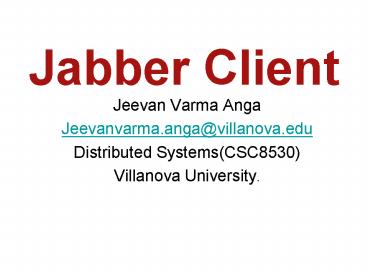Jabber Client - PowerPoint PPT Presentation
1 / 14
Title: Jabber Client
1
Jabber Client
- Jeevan Varma Anga
- Jeevanvarma.anga_at_villanova.edu
- Distributed Systems(CSC8530)
- Villanova University.
2
Vision
- The Jabber Instant Messaging Client has two
goals. The first and most essential, is to
provide an Instant Messaging Service Client. The
second is to allow transparent messaging to third
party services (YAHOO, ICQ, MSN, AIM. etc.)
Jabber History
- Jabber Technology Began in 1998 as an open source
project to enable and ease the construction of
compatible IM clients. - To understand standard XML data types.
- Via a standard TCP socket.
3
What is Jabber?
- Jabber is a set of streaming XML protocols and
technologies that enable any two entities on the
Internet to exchange messages, presence, and
other structured information in close to real
time. The first Jabber application is an instant
messaging (IM) network that offers functionality
similar to legacy IM services such as AIM, ICQ,
MSN, and Yahoo. However, Jabber is more than just
IM, and Jabber technologies offer several key
advantages
- Open
- Standard
- Decentralized
- Secure
- Extensible
- Flexible
- Diverse
4
Why Use Jabber?
- Convenient way to communicate with more immediacy
than e-mail and without the expense of
long-distance phone calls. - Jabber Instant Messaging solution is intended to
allow users to chat not only with other Jabber
users but also with users of AIM, ICQ, MSN
Messenger, and Yahoo Messenger. - Multiplatform support.
- Open-source solution
5
Jabber Architecture
6
Communication Protocol - XMPP
- XMPP - Extensible Messaging and Presence
Protocol. - The Extensible Messaging and Presence Protocol is
an IETF adaptation of the open Jabber protocol
for instant messaging and presence. - XMPP/Jabber is a pure XML protocol which provides
a complete set of IM and presence features on top
of a dedicated data transport layer. - The basic technology involves negotiating an XML
stream between client and server using the Simple
Authentication and Security Layer (SASL) and
Transport Layer Security (TLS) protocols to
secure the stream. - Exchange of fragments of XML over the stream in
order to engage in common functionality such as
sending messages, chatting with contacts,
modifying presence, and managing a contact list.
7
- There are three basic types of XML fragments
used in Jabber - Messages (ltmessage /gt)
- Presence (ltpresence /gt)
- Info/Query (ltiq /gt
- Sample XML fragments
- Client
- lt?xml version'1.0'?gt
- ltstreamstream tojabber.dk' xmlns'jabberclient
' xmlnsstream'http//etherx.jabber.org/streams'
version'1.0'gt - Server
- lt?xml version'1.0'?gt
- ltstreamstream from'example.com' id'someid'
xmlns'jabberclient' - xmlnsstream'http//etherx.jabber.org/streams'
version'1.0'gt
8
- ltmessage toabc_at_example.net' fromxyz_at_example.co
m/Work' type'chat'gt - ltbodygtGood Evening!lt/bodygt
- lt/messagegt
- Client
- ltiq type"get" idSomeId"gtltquery
xmlns"jabberiqroster"/gt - lt/iqgt
- Server
- ltiq type'result' idSomeId' from'jabber.dk
toabc_at_jabber.dk/Work'gt - lt/iqgt
- ltpresence fromabc_at_example.net
toxyz_at_example.net'gt - ltshowgtawaylt/showgt
- ltstatusgtbe right backlt/statusgt
- ltprioritygt0lt/prioritygt lt/presencegt
9
Conclusion
- The Jabber messaging framework is an example of
P2P environments using XML technology. This
framework includes its own communications
protocol and server architecture and is based on
the concept of switching XML document content
between multiple locations. - All messages in Jabber framework, including
instant message content, presence changes, and
configuration updates, are delivered as XML
fragments. This forms the critical ingredient in
peer-to-peer information sharing schemes,
including grid computing, instant messaging, and
Web services. - Considering the low cost of hardware and that
the technology is effectively free, a full
implementation of Jabber has the potential to
make a positive impact on a network for a minimal
outlay. - Based on these facts - it may well be the future
of Instant Messaging.
10
Snapshots
11
(No Transcript)
12
(No Transcript)
13
(No Transcript)
14
References
- JSF, Jabber Protocol,
- URLhttp//www.jabber.org/ietf/
- Peter Saint-Andre, JEP-0078 Non SASL
authentication, URLhttp//www.jabber.org/jeps/je
p-0078.html - Jive Software, Smack API,
- URLhttp//www.jivesoftware.com/xmpp/smack/api/
- Patrick Chan, The Java Developers Almanac 1.4,
- URLhttp//javaalmanac.com/egs/javax.swing.tree/A
ddNode.html - Sun Microsystems, How to use trees?,
URLhttp//java.sun.com/docs/books/tutorial/uiswin
g/components/tree.html - Smack Library Forum, URLhttp//www.jivesoftware.c
om/jive/forum.jspa?forumID39 - Ana Orubeondo, Blind to brand name, InfoWorld
(August 24, 2001).































